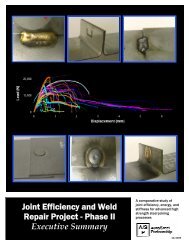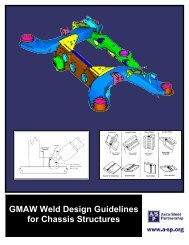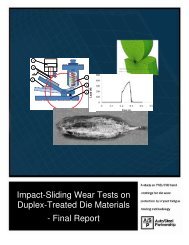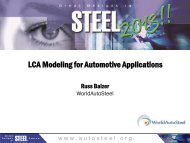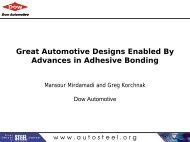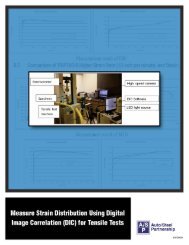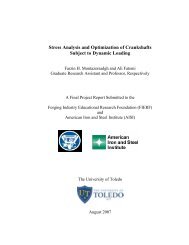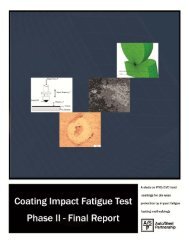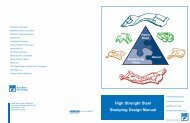Light Truck Frame Joint Stiffness Study Phase 1 Final Report
Light Truck Frame Joint Stiffness Study Phase 1 Final Report
Light Truck Frame Joint Stiffness Study Phase 1 Final Report
You also want an ePaper? Increase the reach of your titles
YUMPU automatically turns print PDFs into web optimized ePapers that Google loves.
APPENDIX A: ABSTRACTS<br />
27. A <strong>Study</strong> on the Improvement of the Structural <strong>Joint</strong> <strong>Stiffness</strong> for Aluminum BIW<br />
Lee, Young Woong; Kwon, Yong Woo; Kwon, Soon Yong; and Cho ,Won Suk<br />
SAE Paper 970583; Feb 1997<br />
The application of aluminum Body-In-White has several technical barriers in press forming, joining,<br />
and chemical conversion treatment processes. Among them, the optimization of joining processes<br />
with which structural stiffness and durability will be assured might have the key role for the success of<br />
aluminum applications to BIW. In this study, stiffness, strength and fatigue strength of BIW joints with<br />
aluminum sheets were evaluated as a function of joining methods, such as resistance spot welding<br />
and weld bonding, via both experimental and analytical routes (FEM). For the evaluation, single-lap<br />
joint and T-shaped joints were made, with each joining method, as variation of pitch, sheet thickness<br />
and even materials – steel sheets. Based on the experimental and FEM analysis results, the optimum<br />
joining method for the aluminum BIW which is suitable for weight saving and has equivalent stiffness<br />
and strength to steel is suggested. In addition, for obtaining optimum processes with improved<br />
stiffness, and strength of the joining method, design parameter, such as the influence of the spot pitch<br />
on the structural joint stiffness and the minimum wall thickness of aluminum which is able to maintain<br />
the equivalent stiffness and strength to steel are discussed.<br />
28. Testing of Semi-Rigid Unbraced <strong>Frame</strong>s for Calibration of Second-Order Inelastic Analysis<br />
Liew, J.Y.R.; Yu, C.H.; Ng, Y.H.; and Shanmugam, N.E.<br />
Journal of Constructional Steel Research; No. 2/3; 1<br />
This paper examines the behavior of semi-rigid unbraced frames through a series of tests on a variety<br />
of rectangular frames as well as their joints so that the analysis and design methodology can be<br />
developed and verified against the test results. The frame and joint tests employed similar beam and<br />
column sizes and had the same connection details. The two types of connections studied were topseat-double-web<br />
angle and extended end-plate. Column-base connections were also included in the<br />
studies. Load-displacement plots are presented for all the test frames subjected to gravity loads<br />
applied to the beam and columns, and a horizontal load applied at the beam level. The principal<br />
objective of the joint tests is to provide a comprehensive set of moment-rotation data, in terms of<br />
stiffness and moment capacity, so that a comparative assessment of the frame performance due to<br />
the different connection types could be undertaken. Detailed descriptions of test arrangement, load<br />
sequences, test methods and data acquisition techniques are given. The general observed behavior<br />
is discussed. Results from the frame tests are compared with the corresponding theoretical results<br />
obtained from a second-order inelastic analysis.<br />
29. The Flexibility of a Tubular Welded <strong>Joint</strong> in a Vehicle <strong>Frame</strong><br />
Lubkin, James L.<br />
SAE Paper 740340, 1974<br />
Automotive frames frequently consist of thin tube members thick enough for much of the structure to<br />
be modeled adequately by bar elements. However, previous results show that a typical welded joint<br />
cannot be handled by the classical “rigid joint” assumption of frame analysis. Those results include<br />
tests of a joint type common in passenger car frames, and establish errors of over 60% in analytical<br />
predictions for some of the lower natural frequencies. The present paper attempts to see how much<br />
improvement we can achieve by simply accounting for the actual tubular shape in the vicinity of the<br />
joint, without allowing for the flexibility of the weld line itself. The study uses the NASTRAN computer<br />
program. The joint region is treated as a small substructure in a model otherwise composed of bar<br />
elements. This procedure is economical because only those portions which really have to be<br />
analyzed using plate elements are so treated. Parameters investigated include joint length, and two<br />
ways of attaching a shell to adjacent bar elements. The present results reduce the worst two<br />
<strong>Report</strong>: A/SP-005-1 <strong>Light</strong> <strong>Truck</strong> <strong>Frame</strong> <strong>Joint</strong> <strong>Study</strong> 77



